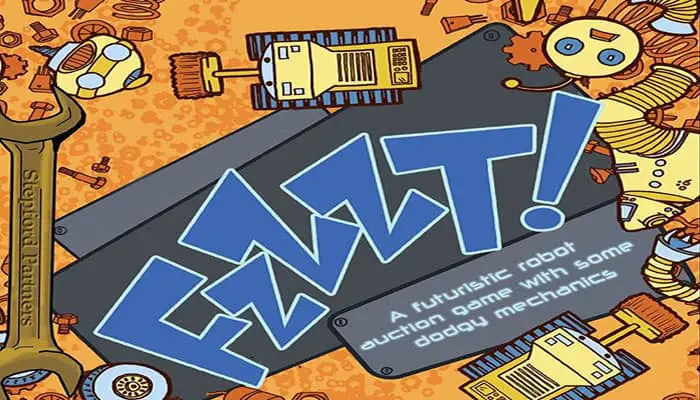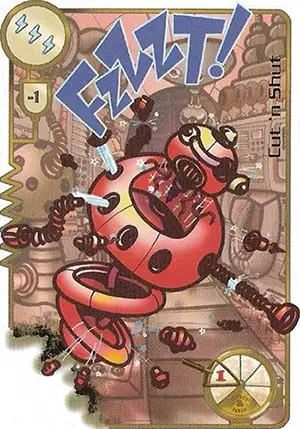

Tomorrow's world is here today! A world where strange and crazy robots are built in a crackpot factory, and the players (mechanics) compete to collect them as they fall off become available on the conveyor belt.

Components
- 4 Mechanic cards
- 36 power Robot cards ards
- 2 Robot Upgrade cards
- 4 Fzzzt cards
- 10 Production Unit cards
We suggest that the game is played with a metal spanner (not supplied) to indicate which player is the Chief Mechanic.
Alternatively use the game box, which has a spanner illustrated on one side.

Object of the Game
Fzzzt! is a five-round, set-collecting, sci-fi auction game with robots and production units individually sold to the highest bidder.
Mechanics pay for new cards using the power ('zaps') of one or more robot cards in hand which include those previously purchased.
Mechanics can also assign cards to production units for bonus points. The winner is the mechanic with the most points.
Setup
For a two player game, remove the Mechanic cards numbered 3 and 4. For a three player game, remove the Mechanic card numbered 4. These Mechanic cards are not used. For a four player game, use all the Mechanic cards.
Shuffle the Mechanic cards and deal one to each player. The player with the Mechanic card numbered '1' is the Chief Mechanic at the start of the game. The Chief Mechanic takes the game box (or the spanner) and is the starting player for the first Auction Round.
Players take the Robot cards marked with their Mechanic card number, so that each player has a 1 power, 2 power and 3 power Robot card. Together with the Mechanic card, these three cards form the player's hand at the start of the game.
The Chief Mechanic now takes the rest of the Conveyor Belt Deck cards and shuffles them, placing the Deck face down at one end of the table with enough space for eight cards to be placed in a single line away from the Deck.

Card Overview
Robot Cards

Fzzzt Cards
Each Fzzzt card adds three power to a bid, but is worth minus one point during scoring at the end of the game and does not have a Construction Symbol (so it can't be used on Production Units).
Production Unit and Mechanic Cards
Construction Symbols

Auction Rounds
An Auction Round is made up of eight individual auctions. In each auction players use one or more of their cards in hand to bid for the card at the head of the Conveyor Belt (furthest from the Conveyor Belt Deck).
Auctions continue until all eight cards have been won, then the current Auction Round ends.
During the Auction Round a number of the cards in the line will be turned face up, so that players can see some of the cards that will be available for purchase later in the round.
Each Auction Round is made up of three phases:
- Preparation
- Auctions
- Clean up and building Production Units
Preparation

Each player shuffles their own personal cards, except for any Production Units they have won, and deals six cards to form their hand.
If a player has less than six personal cards (for example, at the start of the game each player will only have four cards), then deal them all.
Any remaining personal cards are placed face down in front of the player to form a personal discard pile.
The Chief Mechanic lays out eight cards from the Conveyor Belt Deck face down in a single line away from the Deck to form the Conveyor Belt.

The Chief Mechanic turns up the card at the head of the Conveyor Belt - the card furthest from the Conveyor Belt Deck. This card will be the first card to be auctioned.
The Belt Speed Number on the card at the head of the Conveyor Belt shows how many cards will be turned face up before the first auction starts. A Belt Speed Number can be 1, 2, 3, 4 or 8.
If the Belt Speed Number is 1, then no more cards are turned up. If it is 2, 3 or 4, then the Chief Mechanic turns up the next card or cards in the line, so that the number of face-up cards equals the Belt Speed Number. If the Belt Speed Number is 8, turn up all remaining cards in the line.
The Belt Speed Numbers on the other face-up cards are ignored.
After all of the current batch of face-up cards have been auctioned, the Chief Mechanic turns up the next face-down card and consults its Belt Speed Number, turning more cards in the line face up if necessary.
If insufficient cards remain in the line, do not draw more cards, simply ignore the excess. For example, if there are three face-down cards left when the last face-up card has been auctioned, and the first of these cards has a Belt Speed Number of 4, turn up just the remaining two cards.
Auctions

Taking turns in clockwise order, starting with the Chief Mechanic, each player must choose one or more cards from their hand as a bid for the card at the head of the Conveyor Belt.
Players must place the bid card(s) face down in front of them (away from their discard pile), so that the other players can see how many cards have been chosen, but not what they are.
When all players have chosen their bid cards, all bids are revealed simultaneously. The value of a bid is the sum total of the power on the cards in the bid.
For example, the value of a bid of a 2 power Robot card and a 4 power Robot card is 6; the value of a bid containing just a Mechanic card is 0; the value of a bid of a Fzzzt card and a Robot Upgrade is 3 (the Fzzzt card has 3 power in the auction but is worth minus one point at the end of the game; the Robot Upgrade has zero power).
 Robot Cards |
The player with the highest bid wins the auction.
If the auctioned card is a Robot card, it is put face down into the winner's discard pile, together with the cards the winner used to make the bid. If it is a Production Unit card, it is placed face up in front of the winner; these cards are used during scoring at the end of the game.
The other players return their bid cards to their hands.
Tied Bids
If the result of the bids is a tie, and one of the tied players is the Chief Mechanic, then the Chief Mechanic wins the auction. If the tied players do not include the Chief Mechanic, then the tied player nearest to the Chief Mechanic in a clockwise direction wins the auction.
After the tie has been resolved, the losing tied player nearest to the winner of the auction in a clockwise direction gains the game box (or spanner) and becomes the new Chief Mechanic.
No Cards Left in Hand

If all players have run out of cards in hand at the end of an auction but before the current Auction Round has been completed, then each player takes back all of his or her discarded cards, including any Robot cards that have been won, shuffles them and deals a new hand of six cards.
Any remaining cards will form a new personal discard pile. Remember to leave any Production Unit cards face up in front of their owners. Then continue the auctions to finish the Auction Round.
If at least one player has cards in hand, auctions continue, but players with no cards in hand cannot bid and cannot win cards.
General Note Concerning Auction Etiquette
Players may not trade any of their cards, nor may they use cards on behalf of other players. However, other verbal deals are permitted, but unenforceable.
Counting Cards
Players may count the cards in the Conveyor Belt Deck and in their own discard pile at any time. Players are not permitted to look through their own or any other player's personal discard pile during individual auctions.
Clean Up and Building Production Units

When all the cards in the line are gone, the Auction Round ends.
Each player picks up his or her cards, including personal discards and cards in hand, but not including any Production Unit cards or Robots allocated to them previously.
Each player may now look through his or her cards and allocate one card face up to each Production Unit he or she has in play.
For example, if Anne has two Production Units in front of her, she may allocate one card to each Unit, but not two to one Unit. A Construction Symbol (nut, oil, cog, or bolt) on an allocated Robot card must match a Construction Symbol on the Production Unit.
Once allocated these cards are fixed, and players cannot reallocate them later in the game.
Note: Players do not need choose a specific symbol for allocated Robot cards with multiple symbols at this point - the symbol can be chosen at the end of the game. See 'Scoring' section.
When players have finished allocating cards to Production Units, each player shuffles their remaining cards and deals a new hand of six cards for the next Auction Round.
If there are insufficient cards remaining in the Conveyor Belt Deck to complete a new line of eight cards, then the game ends, and players add up their scores.
Scoring
At the end of the game, each player works out their basic score by adding up the points value of each Robot card in their discard pile, cards in hand and cards allocated to Production Units. Fzzzt cards are worth minus one point each.
 Fzzz Card |
Players that have Production Unit cards can now allocate their remaining cards to them to earn bonus points for creating widgets (sets of Robot cards). Each widget earns its owner the points shown on the Production Unit card.
Widgets are created by allocating Robot cards with symbols that match the ones on the Production Unit card in the required combinations. Only one symbol on each Robot card can be used in the creation of a single widget.
Each Robot card can be used in only one widget. Players can create multiple widgets using a single Production Unit card, if the player has enough matching Robot cards.
If any Production Unit has not had at least one widget created with it, then the owning player reduces his or her bonus points by the points stated on the card.
Add each player's bonus points to their basic score to arrive at the player's final score.
End of the Game
The winner is the player with the most points.
If there is a tie, then the tied player who has collected the fewest Robot cards is declared the winner. If there is still a tie, then all of the tied players win.
Continue Reading
